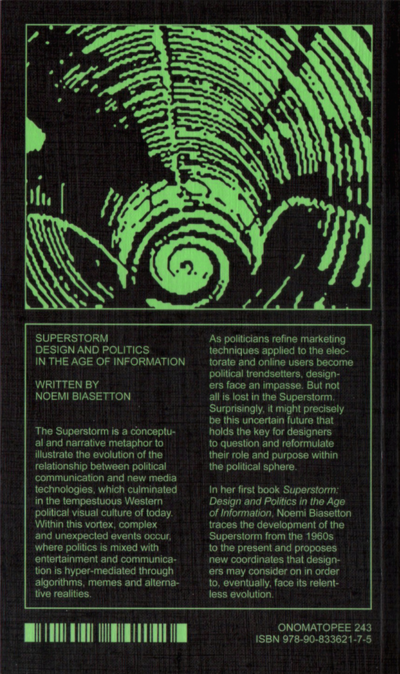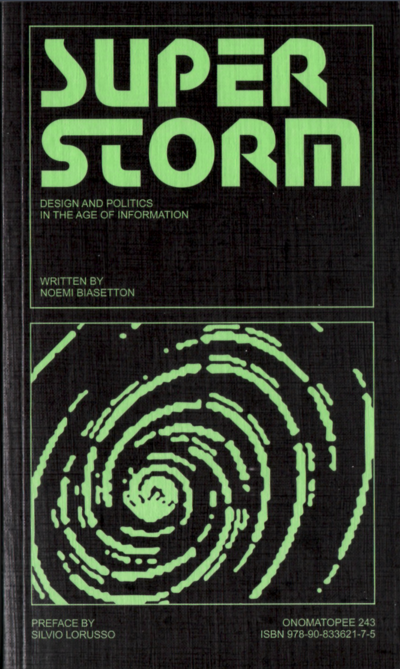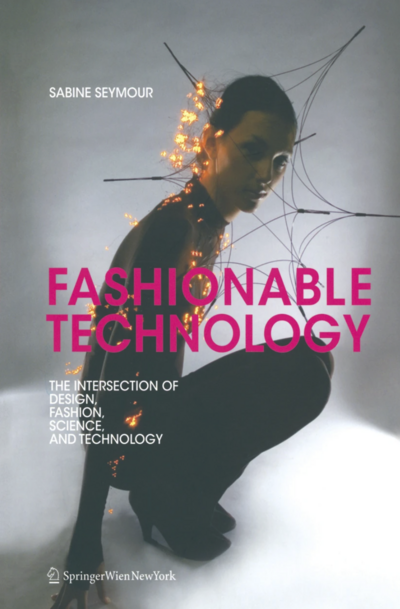[001]
Fashionable Technology
Individual
autonomous
This book provides an accessible yet thorough overview of electronic textiles and wearable technology, exploring the intersection of fashion, design, and science. Exploring both theory and practice, it demonstrates how technology is integrated into fabrics and garments with detailed explanations and rich visual examples. With contributions ranging from the MIT Media Lab to designer Hussein Chalayan, Seymour showcases a variety of pioneering designers, artists, companies, and research institutes, and highlights their groundbreaking projects alongside surveys of their wider work.
22.12.25
[007]
Zeros and Ones: Digital Women and the New Technoculture
Individual
critical
Zeros and Ones is an investigation of the intersection between women, feminism, machines and in particular, information technology. Arguing that the computer is rewriting the old conceptions of man and his world, it suggests that the telecoms revolution is also a sexual revolution which undermines the fundamental assumptions crucial to patriarchal culture. Historical, contemporary and future developments in telecommunications and in IT are interwoven with the past, present and future of feminism, women and sexual difference, and a wealth of connections, parallels and affinities between machines and women are uncovered as a result. Challenging the belief that man was ever in control of either his own agency, the planet, or his machines, this book argues it is seriously undermined by the new scientific paradigms emergent from theories of chaos, complexity and connectionism, all of which suggest that the old distinctions between man, woman, nature and technology need to be radically reassessed.
22.12.25
[009]
Glitch Poetics
Individual
critical
Glitches are errors where the digital bursts or creeps into our everyday lives as fragmented image, garbled text and aberrant event. Today, when computational technology is integrated ever more closely into bodies and social structures, glitches are considered by artists and companies alike as critical and commercial opportunities, revealing tears in the real-virtual binary. Glitch has also increasingly become a metaphor for understanding the political and ecological shocks the world pushes into the mediasphere each day. In Glitch Poetics Nathan Jones shows how contemporary writers and artists are integrating the glitch as a literary effect, an affective critique and a realist reflection, at a time characterised by breakage, corruption and crisis.
Based on a range of close readings of contemporary literature by writers including Linda Stupart, Sam Riviere, Keston Sutherland, Ben Lerner, Caroline Bergvall, Erica Scourti, David Peace and the internet novelists, and drawing on theories of error, shock, glitch, critical posthumanism and code, Jones lays the groundwork for writing that can productively engage in the new situation for literature in the context of AI, the Anthropocene and the post-digital age. His book articulates the working of error in literary and media practice at the horizon of human and machine language.
“Glitch Poetics resists technofuturism, reinventing errancy as a necessary aesthetic value of (and crucially against) our time.”
22.12.25
[010]
Vertical Atlas
Collaboration
social
How to navigate the rapidly changing digital geopolitics of the world today? How do we make sense of digital transformation and its many social, political, cultural, and environmental implications at different locations around the world?
Vertical Atlas brings together the insights of a diverse group of internationally renowned artists, scientists and technologists from different backgrounds and places. From an investigation into the lithium mines in the Democratic Republic of Congo to maps of the fiber-optic submarine cables in the Atlantic and the ride-hailing platforms of China.
Vertical Atlas is not a classic atlas that depicts the world in a uniform manner and it is not a simple collection of traditional maps. This book is a tool that enables comparisons, connections and contradictions between different and diverse visions, realities and worlds – through newly commissioned diagrams, interviews, essays and works of art by leading experts from around the world.
22.12.25
[017]
Digital Research Methods in Fashion and Textile Studies
Individual
pedagogy
Digital Research Methods in Fashion and Textile Studies presents the reader with a variety of digital methodologies to help build skills in searching for, analyzing, and discussing vintage design, photography, and writing on fashion, as well as historic and ethnographic dress and textile objects themselves. Each chapter focuses upon a different method, problem, or research site, including:
- Maximalism and mixed-methods approaches to research
- Searching large databases effectively
- Pattern recognition and visual searching.
- Critical reading, use, and citation of social media texts
- Digital ethnography and shopping as research
- Data visualization and mapping
- Images in the public domain
From advanced undergraduates and postgraduate students working on research projects to veteran professionals in fashion and textile history and beyond, everyone can benefit from a diverse set of fresh approaches to conducting and disseminating research. In the current age of instant gratification, with users snapping and posting images from runway shows long before the clothes will ever appear instores, the world of fashion is increasingly digital and fast-paced. Research on fashion is, too. Digital Research Methods in Fashion and Textile Studies will help you keep up in this rapidly changing world.
22.12.25
[023]
SUPERSTORM. Design and Politics in the Age of Information
Individual
politics

SUPERSTORM. Design and Politics in the Age of Information, 2024 - Cover (Credits: Noemi Biasetton)

SUPERSTORM. Design and Politics in the Age of Information, 2024 Backcover (Credits: Noemi Biasetton)
The Superstorm is a conceptual and narrative metaphor to illustrate the evolution of the relationship between political communication and new media technologies, which culminated in the tempestuous Western political visual culture of today. Within this vortex, complex and unexpected events occur, where politics is mixed with entertainment and communication is hyper-mediated through algorithms, memes and alternative realities.
As politicians refine marketing techniques applied to the electorate and online users become political trendsetters, designers face an impasse. But not all is lost in the Superstorm. Surprisingly, it might precisely be this uncertain future that holds the key for designers to question and reformulate their role and purpose within the political sphere.
In her first book Superstorm: Design and Politics in the Age of Information, Noemi Biasetton traces the development of the Superstorm from the 1960s to the present and proposes new coordinates that designers may consider on in order to, eventually, face its relentless evolution.
22.12.25
[029]
Girl Online: A User Manual
Individual
social
What happens when a woman goes online? She becomes a girl.
The unwritten contract of the internet, that a user is what is used, extends from the well-examined issue of data privacy and consent to the very selves women are encouraged to create in order to appear. Invited to self-construct as 'girls online', vloggers, bloggers and influencers sign a devil's bargain: a platform on the condition they commodify themselves, eternally youthful, cute and responsibility-free, hiding offline domestic, professional and emotional labour while paying for their online presence with ‘accounts’ of personal ‘experience’. Can a Girl Online use these platforms not only to escape meatspace oppressions, but as spaces for survival, creativity and resistance?
Told via the arresting personal narrative of one woman negotiating the (cyber)space between her identities as girl, mother, writer, and commodified online persona, Girl Online is written in a plethora of the online styles, from programming language to the blog/diary, from tweets to lyric prose, taking in selfies, social media, celebrity and Cyberfeminism.
22.12.25
[032]
Glitch Feminism: A Manifesto
Individual
critical
A new manifesto in cyberfeminism: finding liberation in the glitch between body, gender and technology.
The divide between the digital and the real world no longer exists: we are connected all the time. How do we find out who we are within this digital era? Where do we create the space to explore our identity? How can we come together and create solidarity?
The glitch is often dismissed as an error, a faulty overlaying, but, as Legacy Russell shows, liberation can be found within the fissures between gender, technology and the body that it creates. The glitch offers the opportunity for us to perform and transform ourselves in an infinite variety of identities. In Glitch Feminism, Russell makes a series of radical demands through memoir, art and critical theory, and the work of contemporary artists who have travelled through the glitch in their work. Glitch Feminism shows how the error can be a revolution.
“Within glitch feminism, glitch is celebrated as a vehicle of refusal, a strategy of nonperformance.”
22.12.25
[052]
Xenofeminism
Academia
speculative
In an era of accelerating technology and increasing complexity, how should we reimagine the emancipatory potential of feminism? How should gender politics be reconfigured in a world being transformed by automation, globalization and the digital revolution?
These questions are addressed in this bold new book by Helen Hester, a founding member of the ‘Laboria Cuboniks’ collective that developed the acclaimed manifesto ‘Xenofeminism: A Politics for Alienation’. Hester develops a three-part definition of xenofeminism grounded in the ideas of technomaterialism, anti-naturalism, and gender abolitionism. She elaborates these ideas in relation to assistive reproductive technologies and interrogates the relationship between reproduction and futurity, while steering clear of a problematic anti-natalism. Finally, she examines what xenofeminist technologies might look like in practice, using the history of one specific device to argue for a future-oriented gender politics that can facilitate alternative models of reproduction.
22.12.25
[057]
The Wretched of the Screen
Individual
politics
In Hito Steyerl’s writing we begin to see how, even if the hopes and desires for coherent collective political projects have been displaced onto images and screens, it is precisely here that we must look frankly at the technology that seals them in. The Wretched of the Screen collects a number of Steyerl’s landmark essays from recent years in which she has steadily developed her very own politics of the image.
Twisting the politics of representation around the representation of politics, these essays uncover a rich trove of information in the formal shifts and aberrant distortions of accelerated capitalism, of the art system as a vast mine of labor extraction and passionate commitment, of occupation and internship, of structural and literal violence, enchantment and fun, of hysterical, uncontrollable flight through the wreckage of postcolonial and modernist discourses and their unanticipated openings.
“Images are no longer passive reflections; they are active agents, manipulated and distorted by the flows of capital and power, reshaping reality in their own fractured, pixelated image.”
22.12.25
[059]
Autotheory as Feminist Practice in Art, Writing and Criticism
Individual
critical
In the 2010s, the term “autotheory” began to trend in literary spheres, where it was used to describe books in which memoir and autobiography fused with theory and philosophy. In this book, Lauren Fournier extends the meaning of the term, applying it to other disciplines and practices. Fournier provides a long-awaited account of autotheory, situating it as a mode of contemporary, post-1960s artistic practice that is indebted to feminist writing, art, and activism. Investigating a series of works by writers and artists including Chris Kraus and Adrian Piper, she considers the politics, aesthetics, and ethics of autotheory.
Fournier argues that the autotheoretical turn signals the tenuousness of illusory separations between art and life, theory and practice, work and the self—divisions long blurred by feminist artists and scholars. Autotheory challenges dominant approaches to philosophizing and theorizing while enabling new ways for artists and writers to reflect on their lives. She argues that Kraus's 1997 I Love Dick marked the emergence of a newly performative, post-memoir “I”; recasts Piper's 1971 performance work Food for the Spirit as autotheory; considers autotheory as critique; examines practices of citation in autotheoretical work, including Maggie Nelson's The Argonauts; and looks at the aesthetics and ethics of disclosure and exposure, exploring the nuanced feminist politics around autotheoretical practices and such movements as #MeToo. Fournier formulates autotheory as a reflexive movement, connecting thinking, making art, living, and theorizing.
“Autotheory—the commingling of theory and philosophy with autobiography—as a mode of critical artistic practice indebted to feminist writing and activism.”
22.12.25
[065]
The Carrier Bag Theory of Fiction
Individual
critical
The Carrier Bag Theory of Fiction, proposed by Ursula K. Le Guin, suggests that storytelling is akin to a "carrier bag"—a container for diverse narratives rather than a linear progression of events. This theory emphasizes inclusivity and multiplicity in storytelling, advocating for narratives that encompass various voices and experiences rather than focusing solely on traditional heroic plots. By framing fiction as a space for collecting and sharing rather than imposing structure, Le Guin encourages a more holistic understanding of literature's role in shaping human experience.
While acclaimed for its radical rethinking of narrative structures, challenging traditional linear storytelling and instead presenting fiction as a collection of diverse, interconnected experiences, Le Guin's perspective is primarily driven by the importance of inclusivity and multiplicity of voices. It considers how narratives can be used to facilitate understanding of complex human experiences, rather than merely serving as vehicles for plot-driven heroics. It takes special note on the act of 'gathering' and is therefore often referred to by collectives and practitioners that focus on gathering tools, people, experiences and non-conformist ways of doing. By advocating this more holistic, and more inclusive approach to storytelling, Le Guin critiques dominant cultural narratives and opens up space for alternative forms of expression.
“A story is like a carrier bag; it holds the experience of many people, not just one.”
22.12.25
[073]
Why We Can’t Have Nice Things : Social Media’s Influence on Fashion, Ethics, and Property
Academia
critical
Minh-ha T. Pham critically examines the intersection of digital culture and the fashion industry, exploring how social media reshapes ideas of creativity, ownership, and ethical labor. Through incisive analysis, Pham unveils how influencers and platforms commodify aesthetics while obscuring labor inequalities and perpetuating exploitative practices. The book critiques fast fashion and intellectual property disputes, highlighting the ethical dilemmas amplified by digital visibility. With its interdisciplinary approach, the text invites readers to reconsider their complicity in sustaining inequitable systems. A timely contribution, it challenges dominant narratives about fashion's democratization.
22.12.25
[089]
Becoming the Product: The Critical Internet Researcher as a Virtual Intellectual
Individual
critical
In Becoming the Product Morgane Billuart traces the evolution of critical internet research, examining the work of figures such as Geert Lovink, Joshua Citarella, Alex Quicho and Sophie Public. Exploring how researchers navigate the demands of the attention economy, the book reflects on the tension between critique and commodification as it traces the shifting strategies of critical research under pressure to perform, produce and build a brand. What happens to critique when intellectual labour becomes part of the content economy? What does it mean to think critically and sustainably online?
Through her own practice, Morgane’s inquiry blurs the line between critique and performance. By hosting two podcasts and maintaining a presence across multiple platforms, including Substack, Instagram and YouTube, she doesn’t just study the dynamics of online visibility — she embodies them.
Her tone shifts from theoretical to personal, revealing a methodological agility attuned to platform aesthetics. By tapping into the systems she critiques, Morgane challenges the divide between observer and participant, and between content and critique. Rather than resolving this tension, her work inhabits it, showcasing the messy, strategic entanglement of intellectual labour and platform capitalism. This is a form of research that is experienced and performed as much as it is written: a vulnerable and incisive mode of enquiry that is shaped from within the infrastructures it studies.
22.12.25


